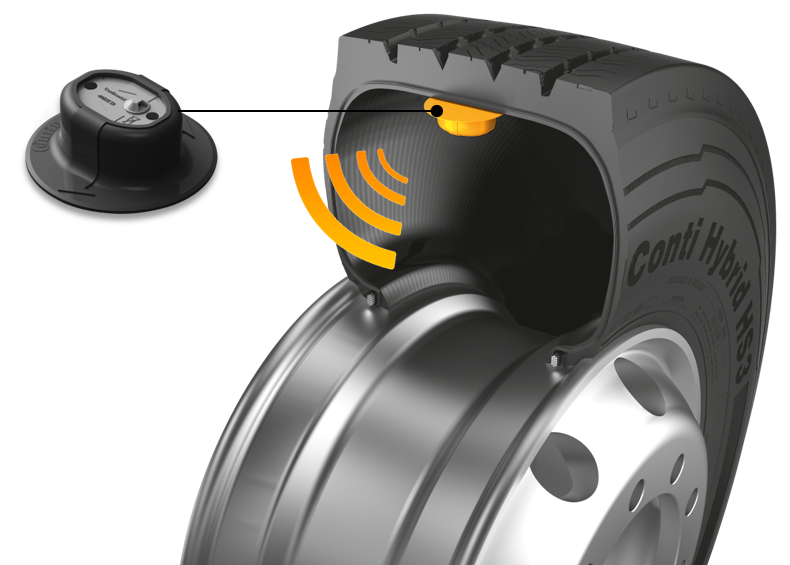Continental's intelligent tire with built-in sensor
Tire pressure monitoring is only the beginning
Proper tire maintenance can have one of the most widespread effects on lowest overall driving cost (LODC) across all fleets. However, consistent monitoring and management of all your fleet's tires is a challenging, often time-consuming task that balances both accuracy and practicality. The most accurate pressure and temperature readings come from sensors mounted in the inner liner of the tire, also known as embedded or integrated tire sensors. In addition, the easiest tire sensors to use and manage are those that you never have to worry about purchasing or installing after the fact. Continental's intelligent tire variants answer both of these requirements which are factory-equipped with smart sensors to save installation and maintenance resources, while guaranteeing optimum positioning and mounting of the sensor for utmost accuracy.

While it is important to monitor tire pressure, tire management requires a range of solutions to help improve LODC. Continental's intelligent tire continuously monitors its performance data which can then be transmitted in real time to the ContiConnect digital tire monitoring platform. This data can then be displayed in the driver cabin, read by the fleet's yard reader, or sent directly to the operator's headquarters via a telematics system. The connectivity between tire, interface, and technician is what ultimately helps fleets save more money through reductions in downtime, roadside incidents, and improper inflation. And it all starts with an intelligent tire.
Benefits of Intelligent Tires
• Accurate tire pressure and temperature readings to prevent tire damage and breakdowns
• Sensor protected from damage in harsh commercial applications
• Warrantied for 4 years to minimize disruptions to your tire program
• Provides true tire casing temperature, allowing preventive actions to increase tire life
• Avoids valve damage and air leaks by mounting on the inner liner of the tire
Properly inflated tires can reduce total tire-related costs by $600 to $800 annually per vehicle.
In addition, digital TPMS solutions from Continental deliver operational benefits to your fleet, such as reducing downtime and saving money. On average, 33% of commercial fleet tires are underinflated. Intelligent tires with digital tire monitoring will help you:
- Improve Tire Runout
- Minimize Irregular Tire Wear
- Save Fuel
- Save Labor & Maintenance Costs
- Reduce Roadside Breakdowns
- Improve Safety
Types of Commercial Tire Sensors
A tire-mounted sensor is attached to the inner liner of the tire. This position delivers significant benefits:
- Protects the sensor from damage from curbing, road debris, etc.
- Avoids theft
- Eliminates the need for a metal clamp
- Will not be damaged during tire mounting or dismounting
- Delivers true tire pressure data via measurement, rather than calculating via an algorithm
- Delivers true tire casing temperature, without influence of heat from braking system
Continental tires can be ordered as intelligent tires directly from the factory, pre-equipped with tire-mounted sensors. The sensors can also be retrofitted into existing dismounted tires. All of Continental’s digital tire monitoring solutions rely on tire-mounted sensors, due to the inherent benefits of this mounting position.
Valve-mounted sensors are often inexpensive and easy to install, but fleets may find the sensors can be damaged by curbing, and in some cases even see them causing tire failure if the valve stem is torn during the event.
It is important to note that tire temperature, one of the key measures to avoid permanent tire damage, is not measured by valve-mounted systems, but rather calculated via an algorithm, which in some cases can lead to inaccurate results.
Wheel-mounted, also called rim-mounted, sensors are attached to the wheel using a metal clamp. While protected from damage caused by curbing, this type of sensor may be damaged during the tire mounting or dismounting process.
In addition, the metal band attaching the sensor to the rim receives heat as the wheel turns, causing expansion and contraction of the clamp. After a period of time, the clamp may loosen and allow the sensor to spin around the rim, causing damage.
In terms of measuring temperature, the sensor can be influenced by heat from the vehicle’s braking system, in which case it would not deliver accurate tire temperature data.
The sensors mounted inside the tire can also be purchased separately and retrofitted. However, ordering Continental's intelligent tire with the premounted tire sensor not only saves on resources for installation, but Continental also guarantees the optimum positioning and mounting of the sensor.
Learn how to mount a tire sensor below:
Cyberbond Installation
REMA TIP TOP Installation
Have questions? Just ask.
We are happy to answer all your questions and support you with our tire expertise.